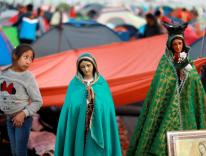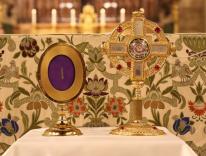John Roberts came from a socially prominent and financially comfortable family. He attended what many considered the most prestigious university in the country before going to law school. An expert advocate, he engaged in vigorous debate about legal matters with the chief justice of the highest court in the land.
But this John Roberts was never nominated to serve on the U.S. Supreme Court. Instead, he was hanged, drawn, and quartered on December 10, 1610, convicted of the capital offense of being a Catholic priest. He was the son of a gentleman, not of a steel plant manager. He studied at Oxford and the London Inns of Court, not Harvard. And the legal debate he conducted with Lord Chief Justice Edward Coke was in Newgate Prison, where Roberts was on trial for his faith, and for his life. He admitted to being a priest and a Benedictine monk, but denied the charge that he had deceived the English people.
In 1970, John Roberts was canonized by Pope Paul VI as one of the Catholic martyrs of England and Wales. Superficial impressions suggest that Supreme Court nominee John Roberts is anything but a candidate for martyrdom. Instead, some people, including some on the Religious Right, suspect he is an ambitious careerist. This suspicion is fueled by the impression that he has been remarkably reticent about his jurisprudential convictions. By all accounts, his legal work has been careful and measured. His colleagues maintain that his professional temperament is, well, judicious: he is open to hearing both sides of an argument, and opposed to crude “us vs. them” characterizations of legal controversies. But this worries some “movement conservatives,” including some Catholics. If you’re nuanced, you’re wishy-washy and can’t possibly believe that anything is worth dying for.
But the martyrdom of John Roberts casts doubt on the charge that nuance and a certain open-minded flexibility are incompatible with deep conviction. The politically active “movement Catholics” of Roberts’s day believed that true commitment to the Catholic faith included a willingness to depose a Protestant sovereign in order to return a Catholic to the throne. Roberts, in contrast, seems not to have been much inclined toward revolutionary plotting; instead, he spent much of his time ministering to plague victims. Politically, Roberts was sympathetic with the group that proposed something like the doctrine of separation of church and state: a good Catholic can be a loyal subject of a Protestant sovereign in matters temporal and political. But a good Catholic priest will never renounce his faith or consent to deprive his flock of the sacraments.
Still, people on all sides of the political spectrum, including Catholics, are worried about Supreme Court nominee John Roberts, largely because he hasn’t forthrightly revealed his basic jurisprudential commitments. Despite the differences, the worry is the same: no one wants to be duped. Liberals worry that Roberts is a stealth Antonin Scalia. Conservatives worry that he is a stealth David Souter. The fear of being duped is hardened into ineluctable opposition by bitterness against perceived past injustices. Democrats think that Bush stole the 2000 presidential election, and by all rights shouldn’t be in a position to appoint anyone to the Supreme Court. Republicans think that the Democrats tried to deprive them of just that opportunity in the late 1980s and the early 1990s, by their treatment of Robert Bork and Clarence Thomas. In this climate, who can blame Roberts for his taciturnity?
The more fundamental question, of course, is how to restore a climate of relative trust, the urgency of which is sharpened by recalling the social and political circumstances in which St. John Roberts found himself. Political divisions, both in the general population and among Catholics, were rife. Catholics were bitter at Henry VIII for rejecting and suppressing their faith, and they blamed Elizabeth I for obtaining the throne by feigning sympathy for it. They resented the severely repressive measures taken late in her reign and in the reign of James I, who had promised tolerance for Catholics. On their part, Protestants bitterly remembered the repressive policies of Queen Mary Tudor, under whom nearly three hundred of their number were burned to death in less than four years. The repressive policies adopted by both Catholic and Protestant rulers were rooted in political insecurity, which was in turn exacerbated by a political climate permeated with deception. Catholics accused Protestants of lying outright; Protestants accused Catholics-particularly Jesuits-of resorting to equivocation, even under oath. The Spanish Armadas of 1588, 1596, and 1597, and the Gunpowder Plot of 1605 left Elizabeth, and then James, feeling assailed by an enemy both fierce and nebulous. They could not fully trust anyone.
That cycle of deception, betrayal, and violence had a long-lasting effect on the political climate in England. But what seems most chillingly relevant to me now is the bitter divisions that existed then among the beleaguered English Catholics themselves. The political divisions, which seemed so important at the time, weakened the Catholic Church in England for centuries. Would the English martyrs, looking at things from the perspective of eternity, say the divisions were worth it? I doubt it.
Please email comments to [email protected] and join the conversation on our Facebook page.
Share
Previous Story
Clearing the Air
Next Story
The Nuclear Option


